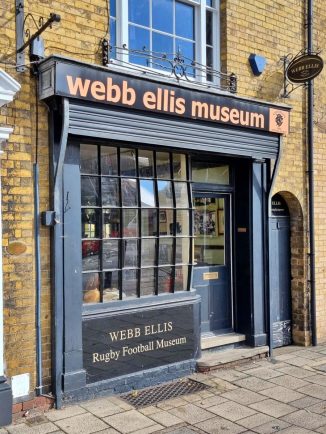AS the Rugby World Cup continues in the sport’s bicentennial year, Karl Quinney explores a hidden corner of Rugby which is home to a world-famous team’s historic archives.
RUGBY School’s status as the birthplace of the game is world-renowned.
However, the town also has another home to a rather special collection of rugby history and memorabilia, including the archives of a world-famous nomadic rugby team and sporting entity.
Opposite the statue of William Webb Ellis is where you will find a hidden gem of a museum.
The Webb Ellis Rugby Football Museum is based in the original building where William Gilbert and then his nephew James made the first rugby footballs in 1842. William was the boot and shoe maker to Rugby School and he operated from a small shop in the town’s High Street a mere two streets away. By 1823 – when William Webb Ellis was creating a piece of sporting history – Gilbert was already supplying balls to Rugby School, and probably the same one which Webb Ellis famously picked up and ran with.
By 1842, business was booming for Gilbert to such an extent that he expanded his football operations and moved his shop to its current location. This tradition still continues today with Webb Ellis Ltd, giving it the accolade and distinction of having the longest continuous association with the game of rugby in the world.
In 1983, the company was taken over by former England international Rodney Webb. At the time there was no museum in Britain dedicated solely to the game of rugby football, so the idea of turning the premises into a museum was created. That came to fruition four years later when it opened to the public.
The museum is free to enter – and a proverbial treasure trove of rugby memorabilia awaits.
The collection is displayed in themed areas which include a focus on the game’s origins, famous players, and history of the game and the ball. Where the latter is concerned, visitors can find out about the traditional manufacture of the rugby ball from its origin as a pig’s bladder to the advanced production which today serves rugby nations and clubs worldwide.
There is also a Gilbert football, similar to those used at Rugby School and exhibited at the first World’s Fair at the Great Exhibition in London in 1851, Charter Day balls, leather stands from 1851 and the original brass hand pump of Richard Lindon, the inventor of the rubber bladder for rugby balls.
The extent of the Museum’s collection of rugby-related items and memorabilia is quite surprising. It includes photos, match programmes, ties and artefacts of every description and from all over the globe.
As part of this impressive historical haul is a considerable collection associated with the Barbarians, the world-famous rugby club which every year brings together players from different clubs and nations to play a series of matches in different locations.
The Baa-Baas, as they are known, may be one of the most famous rugby teams in the sport and across the globe, but they are unique in that they have no home, ground or clubhouse. To play and coach for them is an honour. In fact the clubs the Baa-Baas visit and play pay most of their expenses – meaning the team is in every respect nomadic, a touring club, for there are no ‘home’ matches.
So with no place to call home and store and display items from their travels, a special Barbarians FC section at the Webb Ellis Museum houses shirts, programmes, balls and ties to pay homage to the world’s most famous rugby club.
Lawrence Webb of Webb Ellis told me that around six years ago, they were contacted by the Barbarians FC to see if they could take on and show some BBFC memorabilia. Naturally they jumped at the chance and it has grown from there. They also received some great stuff from Guy Steele-Bodger, son of Mickey Steele-Bodger who was a stalwart of the Barbarians for so long, which certainly gave the collection a boost in variety.
The museum continues to be visited by rugby-playing teams, clubs, schools and colleges as well as fans, followers and supporters of the game whenever they are in town. A visit here is equally as important as paying homage to where the game was born just around the corner.
With this fabulous little corner of rugby hidden away yards from where the game was first born and its balls first created, why wouldn’t you?
The Webb Ellis Rugby Football Museum is open Monday to Saturday, 9am-5pm.











